
The following is Rocket Lab’s announcement regarding the selection by NASA to become launch provider for a small satellite mission to the same lunar orbit targeted for Gateway.
Rocket Lab, a space technology company and global leader in dedicated small satellite launch, has been selected by NASA as the launch provider for a small satellite mission to the same lunar orbit targeted for Gateway – an orbiting outpost astronauts will visit before descending to the surface of the Moon in a landing system as part of NASA’s Artemis program.

Updated illustration of NASA’s CAPSTONE CubeSat. The spacecraft design has changed since the mission contract award in September 2019. Credits: NASA

The Cislunar Autonomous Positioning System Technology Operations and Navigation Experiment (CAPSTONE) is expected to be the first spacecraft to operate in a near rectilinear halo orbit around the Moon. In this unique orbit, CAPSTONE will rotate together with the Moon as it orbits Earth and will pass as close as 1,000 miles and as far as 43,500 miles from the lunar surface. CAPSTONE will demonstrate how to enter into and operate in this orbit as well as test a new navigation capability. This data will help to reduce navigation uncertainties ahead of future missions for Gateway, as NASA and international partners work to ensure astronauts have safe access to the Moon’s surface.
The satellite will be launched on Rocket Lab’s Electron launch vehicle from Launch Complex 2, located within the NASA Wallops Flight Facility in Virginia, USA. After launch, Rocket Lab’s high performance configurable satellite bus platform, Photon, will deliver CAPSTONE on a ballistic lunar transfer. Photon’s Curie propulsion system will allow the satellite to break free of Earth’s gravity and head to the Moon. After launch, CAPSTONE take approximately three months to enter its target orbit and begin a six-month primary demonstration phase to understand operations in this unique orbit. The mission is targeted for launch in early 2021.
Rocket Lab founder and chief executive Peter Beck said that small satellites like CAPSTONE will play a crucial role in supporting the return of human missions to the Moon and they’re proud to be supporting NASA in this unique and pivotal mission. As a dedicated mission on Electron, they’re able to provide NASA with complete control over every aspect of launch and mission design for CAPSTONE, something typically only available to much larger spacecraft on larger launch vehicles. In the same way we opened access to low Earth orbit for small satellites, we’re proud to be bringing the Moon within reach to enable research and exploration.
Supporting the mission on Electron is Space Exploration Engineering, who will contribute to mission planning, trajectory analysis, orbit determination, as well as KSAT who will provide global ground station coverage for the mission.
Note: see Satnews’ article regarding NASA’s announcement regarding CAPSTONE project.
